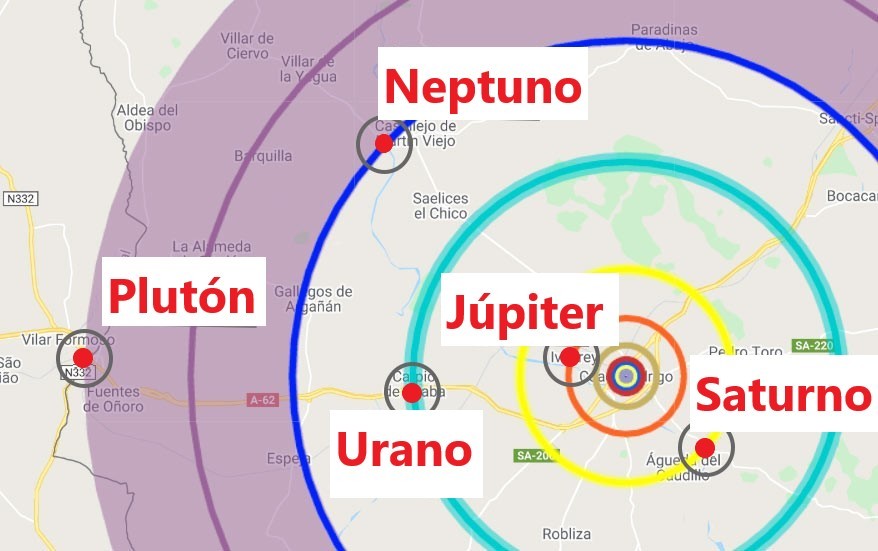This weekend a scale model of the solar system is inaugurated in Ciudad Rodrigo.
The Sun measures 4.8 meters and is located in the center of the city, while Pluto is located more than 20 kilometers away, on the border with Portugal.
It is the first model in Spain of these characteristics and one of the most spectacular in the world.
From the city to Portugal
A group of amateur astronomers from Ciudad Rodrigo has just made a spectacular project come true. It involves the construction, at a scale of 1 / 290,000,000, of a model of the solar system. With a diameter of 4.8 meters, the Sun is located in the Parque la Glorieta, next to the Puerta del Conde of the walled enclosure. The inner planets are located near other positions on the wall: Mercury next to the Puerta del Sol, Venus in the guardhouse of San Pelayo, Earth at the Puerta de Santiago and Mars in the middle of the Puente Mayor. Thus, going from one of these planets to another, the visitor travels part of the bastioned heritage of the city.
Due to the chosen scale, to reach the outer planets you have to leave the city, and that makes us aware of the immensity of our planetary system.
Jupiter, surrounded by its four Galilean moons, is situated on Ivanrey.
Saturno in Sanjuenjo, Urano in Carpio de Azaba and Neptuno in the archaeological site of Siega Verde (which is a UNESCO heritage site).
Location of the inner planets
The authors of the project have not forgotten the dwarf planet Pluto, which has been located in Fuentes de Oñoro, already on the border with Portugal.
From here, as the crow flies, there is little more than 20 kilometers away to Ciudad Rodrigo, which is equivalent to the 6,000 million kilometers that separate Pluto from the Sun.
A ride at the speed of light
At the chosen scale, one kilometer on the map of Spain is equivalent to 290 million in the solar system.
Therefore, the equivalent speed of light on the map is 3.7 kilometers per hour.
That is to say, a leisurely stroller will go through this solar system at the speed of light: leaving from the Sun it will take about 3 minutes to reach Mercury, 8 minutes if it goes to Earth, about 13 minutes if it goes to Mars.
But to reach Jupiter it will need about 43 minutes, 80 minutes for Saturn and about 5 and a half hours to reach Pluto.
Location of the outer planets
Naturally all these numbers are very approximate.
Among other things because the orbits of the planets are elliptical and are sometimes closer and sometimes further from the Sun. But the chosen scale gives us a good idea of the astronomical distances.
For example, to reach the nearest star, Proxima Centauri, which is 4.2 light-years from Earth, our walker would have to travel about 136,000 kilometers, that is, a distance equivalent to one third of the Earth-Moon distance.
Exemplary initiative and collaboration
This project illustrates how the badly called Spain emptied continually surprises us with its infinite good things. That is why I think that, instead of 'emptied', it would be more accurate to speak of 'depopulated Spain'. Ciudad Rodrigo is one of those cities that, despite its sumptuous heritage, has seen its population decline progressively in recent decades, but this does not discourage its citizens, who continue to devise initiatives to attract us to their land.
We must thank and congratulate the astronomical association Astróbriga for this initiative and for all the selfless effort they have put into it.
To finance the project, its partners have shown a lot of imagination.
They mobilized their fellow citizens thanks to the 'Give a hand' campaign to collaborate.
Thanks to this, the sculpture of the Sun is conceived as a mosaic of hands in which the names of almost 2000 people appear who donated a few euros each to collaborate in the project.
Astróbriga also managed to excite the City Council of Ciudad Rodrigo, the Association for the Development of the Region of Ciudad Rodrigo ADECOCIR, the Spanish Foundation for Science and Technology FECYT, as well as several private companies (such as GMV, Iberdrola and ACOFARMA) that have contributed to finance construction.
Visiting this solar system not only illustrates us about astronomy, it also encourages us to get to know this historic city and the interesting Salamanca region.
The organizers have turned the inauguration into a true astronomy festival, with outreach conferences, open-air workshops and observations of the night sky, an event that Astróbriga intends to start holding periodically, once a year.
The skies in the area suffer from little light pollution, which contributes to the potential of the city and its region for astrotourism.
Hopefully we will soon see the dream of Mirobrigenses come true of turning their city into a "city of stars".
_____________________________________________________________________
Rafael Bachiller is director of the National Astronomical Observatory (National Geographic Institute) and academic of the Royal Academy of Doctors of Spain.
According to the criteria of The Trust Project
Know more
Science and Health
science
ASTRONOMY Jupiter, super bright this weekend and in conjunction with the Moon
The Government anticipates that the Spanish vaccine can be marketed in early 2022
Ethology Chimpanzees and bonobos greet each other and say goodbye every time they meet
See links of interest
Last News
Work calendar
Home THE WORLD TODAY
Master Investigation Journalism
La casa de papel premiere
Girona - Sporting de Gijón
Stage 20 of LaVuelta, live: Sanxenxo - Mos.
Herville Castro
Eibar - Leganes

